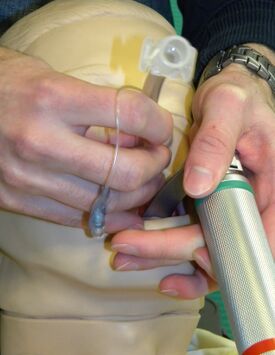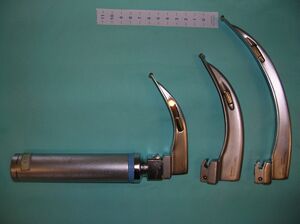Securing the airways (half heels)
Motto Dum spiro, spero. or loosely translated As long as the patient breathes, one can hope.
Securing the airway is a skill required of every person. With the level of education, it is necessary to increase the level of one's skill. Basic is a simple tilt . Maintaining the patency of the airways and maintaining the exchange of respiratory gases is a condition of life. The key place is the area from the root of the tongue to the rings of the trachea .
If the airway needs to be secured, you usually have little time to choose a method and perform the procedure. It cannot be expected with certainty that the first method chosen will be feasible or sufficient. Holding a mask cannot be learned from a picture, and intubation is a procedure mastered after about 20 attempts. During 50 to 100 intubations, you will encounter a "can't intubate, can't ventilate" situation, when it is necessary to use alternative methods (from laryngeal mask to coniopuncture).
Why the airway must be secured (indications)[edit | edit source]
- Developed or worsening impairment of consciousness (including analgosedation and surgery).
- Exhaustion from excessive work of breathing during respiratory failure.
- Obstruction of the upper respiratory tract (facial injury, swelling of the tongue, laryngospasm ).
What options do we have, some advantages and disadvantages, the method of choice[edit | edit source]
Attention - the list of advantages and disadvantages is not exhaustive!
Recovery position:
- + without the need to be present with the patient, reduces the risk of aspiration of stomach contents;
- – spontaneous breathing must be sufficient.
Tilt, forward jaw:
- + necessary skill to perform other methods;
- – spontaneous breathing must be sufficient.
Breathing mask:
- + necessary skill to perform other methods, enables emergency positive pressure breathing ;
- – use of both hands, poorly functional in patients without teeth, obese, facial injuries.
Laryngeal mask with rigid bent tube:
- + emergency option in case of intubation failure, can be introduced from the front, in a semi-sitting position, without leaning back, opening the mouth to 2 cm between the incisors, possibility of use by trained non-medical personnel, possibility of emergency artificial ventilation;
- − the possibility of easy luxation of the mask from the correct position.
- Similarly, other supraglottic devices ( combitube , laryngeal tube) - intended mainly for use by trained non-medical personnel.
- Laryngeal masks with a flexible, straight tube are preferably used in anesthesiology rooms, their introduction requires practice.
- All of the above methods do not prevent aspiration of gastric contents and do not allow major changes in the patient's position.
Endotracheal intubation:
- + prevention of aspiration, the possibility of pressurized breathing and changes in position;
- − mostly necessary administration of muscle relaxants , high current resistance during spontaneous ventilation.
Coniopuncture:
- + entry into the airways below critical points (glottis, epiglottis);
- − invasive procedure.
Ducts are omitted from this list for limited benefit. Tracheostomy is a surgical intervention requiring preliminary securing of the airways.
Some points in the intubation process[edit | edit source]
- Preparation of a wide tube suction cup and other aids.
- Checking the brightness of the laryngoscope.
- Inspection of the introducer (the tip of the introducer must not protrude from the tube).
- Preoxygenation (minimum 2 minutes or 3 breaths, oxygen flow above 13 L/min or reservoir).
- Sellick palpation for fear of regurgitation.
- Relaxation check by pulling on the chin - we detect the relaxation of the masticatory muscles.
- Laryngoscope in left hand, we enter in the right corner.
- Introduce with an arcing motion, then pull up, dislike.
- Protect the incisors .
- Work on your own exhalation, try not to extend it for more than 15 seconds.
- When glottis ligaments are seen, keep pulling on the laryngoscope and check the penetration of the balloon.
- After insertion, fix the tube with your fingers in the right corner until its final fixation with a patch (bandage, fixator).
- To inflate the balloon, only now to release Sellick's touch.
- Ventilation, storage control by triple listening, fogging, capnometry.
Links[edit | edit source]
Related Articles[edit | edit source]
- Securing the airway during anesthesia
- Artificial lung ventilation
- Endotracheal intubation
- Crush introduction to anesthesia
- Difficult intubation
Recommended literature and texts[edit | edit source]
- Jan Bruthans – Ensuring the airway KARIM 1.LF UK (half-hour lecture summarizing the issue with an emphasis on laryngeal mask and intubation)
- Akutně.cz: Difficult airway management in a child - interactive algorithm + test
- Akutně.cz: Management of unexpected difficult intubation - interactive algorithm + test
External links[edit | edit source]
- Prezentace pro postgraduální vzdělávání Michálek: Zajištění dýchacích cest
- Ukázka poklesu brady a použití obličejové masky
- Zajištění dýchacích cest -přehled metod
- MEDICINA.cz: Kardiopulmonální resuscitace v anestesiologii a resuscitaci
- Indian J. Anaesth. (Yathindra, Preethy): Airway management with endotracheal intubation




